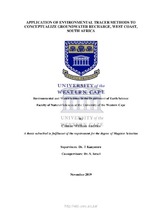| dc.contributor.advisor | Kanyerere, Thokozani | |
| dc.contributor.author | Andries, Clinton William | |
| dc.date.accessioned | 2020-02-27T09:02:38Z | |
| dc.date.available | 2020-02-27T09:02:38Z | |
| dc.date.issued | 2019 | |
| dc.identifier.uri | http://hdl.handle.net/11394/7164 | |
| dc.description | >Magister Scientiae - MSc | en_US |
| dc.description.abstract | Drought and climate change will have adverse consequence for freshwater resources in water stressed South Africa. Diminishing surface water reserves increases the demand to exploit groundwater resources. The drought conditions experienced in South Africa in 2016 is exacerbated in semi-arid portions of the Western Cape, where freshwater resources are further limited. Traditional physical methods are proven to be inadequate in semi-arid and arid regions due to difficulties in accurate measurements of variables for recharge studies. Geochemical methodologies have become more attractive for recharge investigations in drought prone hydrogeological environments due to natural labeling of water throughout the hydrological cycle. Quantitative and qualitative information on aquifer recharge rates and mechanism are needed to manage groundwater resources in the West Coast. Therefore, the aim of this study is to design a hydrogeological conceptual model which describes recharge mechanism and estimates recharge by using combined environmental tracer techniques in coastal aquifer system, using the West Coast Aquifer System as a case study. Groundwater of the upper unconfined aquifer, confined Langebaan Road Aquifer Unit and the Elandsfontein Aquifer Unit, surface water and rainwater samples (n=239) were collected on a quarterly basis during wet winter season (May and August 2017) and dry summer season (November 2017 and February 2018) for stable isotopes and chloride. Tritium and carbon-14 were sampled at selected groundwater monitoring sites (n=31) once during the data collection period.The analysis of groundwater in the unconfined and confined units revealed a similar δ18O‰ and δ2H‰ values which suggests that all aquifer units have the same source of recharge which could possibly be rainfall but at different locations which correlates well with previous stable isotope investigations in the study area. The results revealed that the Berg River is a gaining stream due to significant differences in isotopic composition compared to groundwater. The study also revealed that groundwater at Geelbek Lagoon is not of the same groundwater system as the EAU due to its highly enriched stable isotopic composition which is supported by elevated chloride concentration. This led to the identification of a freshwater/saline water interface in the vicinity of the Geelbek Lagoon. The spatio-temporal assessment of stable isotopes revealed that change in isotopic composition shows a strong relationship with seasonality and amount, as groundwater mimics isotopic composition and evaporation effects of infiltrating in a particular season. | en_US |
| dc.language.iso | en | en_US |
| dc.publisher | University of the Western Cape | en_US |
| dc.subject | Environmental tracer | en_US |
| dc.subject | Groundwater | en_US |
| dc.subject | West Coast, South Africa | en_US |
| dc.subject | Climate change | en_US |
| dc.subject | Rainfall | en_US |
| dc.subject | Methods | en_US |
| dc.title | Application Of environmental tracer methods to conceptualize groundwater recharge, West Coast, South Africa | en_US |
| dc.rights.holder | University of the Western Cape | en_US |

